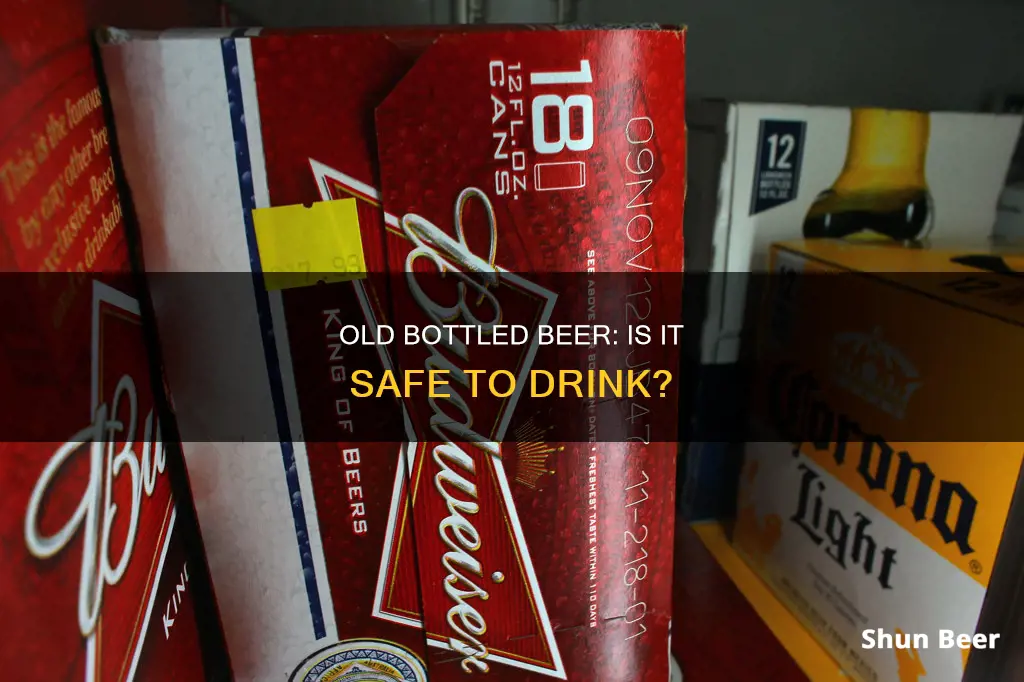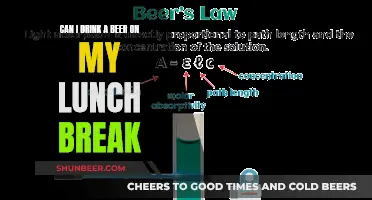
It's generally safe to drink bottled beer past its expiration date, but it may not taste as good. Beer is produced with a best before date, which is a guideline on quality rather than safety. This means that the beer will start to lose its quality after the stated date but can still be consumed. The taste of the beer will depend on how it was stored, with unopened beer lasting up to two or three years if kept in a refrigerator. Beer stored in a room-temperature environment will likely go bad after four to six months.
| Characteristics | Values |
|---|---|
| Safety | Out-of-date bottled beer is safe to drink as no harmful pathogens grow once the beer is fully fermented |
| Taste | Beer will likely have an unpleasant taste and odour |
| Expiry Date | Beer is drinkable for 6-24 months after its best-before date if kept in the fridge, and up to 9 months if not refrigerated |
| Storage | Beer should be stored in a cool, dark place, away from temperature fluctuations |
| Type of Beer | Stronger beers such as stouts and porters tend to last longer than lighter beers like lagers and pilsners |
What You'll Learn

Is it safe to drink out-of-date beer?
Beer typically has a 'best before' date, which is different from a 'use by' date. While the former is more of a guideline on quality, the latter is a rule that should be followed for safety reasons. This means that, while drinking beer past its 'best before' date is not dangerous for your health, it may not taste as good.
Beer is unlikely to pose health risks when consumed past its 'best before' date, as the alcohol and hops—which have antimicrobial characteristics—prevent pathogenic growth. However, the flavour and quality of the beer will degrade over time. This is due to a process called oxidation, which causes the beer to stale, producing off-flavours and an unpleasant bitterness. The volatile aromas from hops, which give beer its distinctive hoppy aroma, also tend to dissipate over time.
The rate at which beer goes bad depends on various factors, such as the type of beer, the quality of the bottling process, and how it is stored. Beer stored in transparent or green bottles is more susceptible to light exposure, which can cause a chemical reaction with certain hop compounds, resulting in an unpleasant skunk-like smell and taste. Beer stored in brown bottles, or in cans, is better protected from light and will retain its quality for longer.
It is recommended to store beer in a cool, dark place, away from temperature fluctuations, and to keep it upright to minimise oxidation. Refrigeration can help extend the shelf life of beer, with unopened bottles or cans lasting up to two or three years in a refrigerator. At room temperature, beer will last about 5 to 9 months beyond its 'best before' date.
In summary, while it is generally safe to drink beer past its 'best before' date, the taste and quality may not be optimal. To ensure the best drinking experience, it is advisable to consume beer as fresh as possible, especially for hop-heavy styles like IPAs.
Beer and Pizza: A Match Made in Heaven?
You may want to see also

How long does beer last beyond its expiration date?
Beer does expire, but it doesn't become unsafe to drink. The worst thing that will happen if you drink expired beer is that it will taste unpleasant. Beer typically lasts for about 6 to 9 months beyond the dates on the label. However, this does depend on how the beer is stored. At room temperature, beer will last about 5 to 9 months beyond the expiration date listed on the label. In a refrigerator, beer can last up to an additional two or three years. This applies to bottled beer, cans, growlers, etc. Opened beer has a shelf life of about a day, regardless of the expiration date listed.
Some beers can improve with age. Richer and higher ABV varieties of beer, such as porters and stouts, can get better with age. This happens best under cool, dark storage conditions like a basement or cellar. IPAs, on the other hand, lose their flavour and aroma over time and are best consumed as soon as possible.
The type of beer affects its shelf life. Stronger beers, such as stouts, porters, and high-alcohol content beers, tend to last longer than lighter beers like lagers and pilsners. Beers packaged in clear or green bottles will have shorter expiration dates as light exposure speeds up the oxidation of beer and deteriorates flavours. Brown bottles offer better protection, and cans completely shield beer from light, helping to preserve its quality longer.
Should Large Dogs Drink Beer?
You may want to see also

How to identify expired beer?
Beer doesn't spoil in the same way as perishable foods like milk. It doesn't turn mouldy or sour, but instead, its taste and quality deteriorate over time. Here are some ways to identify if your beer has expired:
Off-Flavours and Aromas
- A skunky or sulfuric smell, similar to skunk spray, indicates that the beer is lightstruck, or exposed to UV light.
- A stale or cardboard-like taste is caused by oxidation, which occurs when oxygen reacts with the beer's chemical makeup, breaking down hop oils and other flavour compounds.
- An unexpected sour or vinegary taste in non-sour beers indicates bacterial contamination.
- A metallic taste suggests contamination or poor-quality packaging materials.
- A musty or mouldy flavour may be due to mould from improper storage.
- A faded aroma could mean the beer has aged poorly or been improperly stored.
- Any unexpected or unpleasant smells, such as rotten eggs, band-aid, or dampness, suggest spoilage or contamination.
Appearance
- An unexpected haze or cloudiness in a previously clear beer may indicate spoilage.
- Excessive sediment or floaties in the beer can be a sign of spoilage, although some unfiltered beers naturally contain sediment.
- Darkening or discoloration, such as a murky brown in a light beer, may suggest oxidation or contamination.
Carbonation and Head Retention
- Flat beer, with little to no head and lacking carbonation, may have gone flat due to age or improper sealing.
- Over-carbonation or excessive fizziness could indicate unwanted secondary fermentation caused by microbes.
- Lack of foam: Fresh beer typically has a good head when poured, so if there's little to no foam, it may be stale.
- A thin or watery taste may indicate that the beer has lost its carbonation or has degraded.
- A syrupy or thick texture might be a sign of improper ageing or contamination.
Other Factors
- Check the packaging for any signs of damage or improper sealing. Look for a best-before date to gauge freshness.
- Inspect the label for dust, which could indicate that the beer has been sitting on the shelf for a while.
- Check for leakage around the sealed mouth of the bottle, which may indicate that the beer has been subjected to high temperatures.
A Note on Safety
Although drinking expired beer is generally unpleasant, it is usually not hazardous to your health. However, unpasteurized craft beer that has expired can make you sick, so it is best to avoid consuming it if it is stale.
Drinking Beer in Rome: What You Need to Know
You may want to see also

How to store beer to maintain freshness?
Beer is best stored in a cool, dark place. The colder the beer is stored, the longer it will stay fresh, but it's important to note that beer shouldn't be frozen. The ideal temperature range for storing beer is between 45 and 55 degrees Fahrenheit, or 2-7 degrees Celsius. Beer can be stored at room temperature, but it will only stay fresh for up to six months. If stored in a refrigerator, it will last for up to eight months.
It's also important to keep beer out of direct sunlight. Sunlight can cause a chemical reaction in the beer, breaking down its flavour components and causing it to smell and taste like skunk spray. This is why beer bottles are often brown, as this colour blocks 98% of the damaging wavelengths of light. Green bottles only prevent 20% and clear bottles offer no protection.
Beer should be stored in an upright position, to minimise the surface area exposed to oxygen. Storing beer on its side makes it prone to air leaks.
Different types of beer have varying expiration timelines. Some beers are best consumed fresh, within a few months of packaging, while others with a high alcohol content or bottle-conditioned beers can be aged for years. Lighter beers, like pale ales, IPAs, wheat beers and lagers, should be drunk within three months of packaging. IPAs can last for up to 12 months, but the quality will start to decline after a few months. Heavier beers, like stouts and porters, have a shelf life of about six months.
If you're storing beer in a cellar, keep it at a temperature that's around 10 degrees below the beer's fermentation temperature.
Antibiotics and Alcohol: Is Beer Safe?
You may want to see also

What are the best types of bottles for beer?
When it comes to choosing the best type of bottle for beer, there are several factors to consider, including size, shape, colour, and closure type.
Firstly, you should determine the capacity of the bottle. The traditional standard longneck bottle holds 12 oz of beer, which is the most common size found in six-packs. However, larger bottles, such as the 22 oz "bomber" bottles, are gaining popularity for craft and specialty beers. For true beer enthusiasts, individual bottles as large as 40 oz, commonly known as a "Forty", are also available. Beer growlers, which are oversized containers for multiple servings of draft beer, come in sizes ranging from 32 oz to 128 oz.
The shape of the bottle can also impact your marketing strategy and the overall presentation of your beer. Shoulders can be tapered, or the bottle can feature a wider body or longer neck. The longneck bottle, with its slender body and iconic long neck, is the industry standard. However, the heritage bottle offers a unique alternative with its stockier build and shorter, wider neck. Other options include the stubby bottle, which is short and stout, and the Belgian-style bottle, which resembles a champagne bottle.
The colour of the bottle is not just an aesthetic choice. Clear or light-coloured bottles are more susceptible to spoilage due to light exposure, so amber (brown) bottles are often preferred as they block up to 98% of the damaging wavelengths of light. Green bottles only prevent 20% of light, while clear bottles offer no protection.
Finally, the type of bottle you choose will determine the closure type. The most common cap for individual beer bottles is the Crown Beer Bottle Cap, which comes in pry-off or twist-off varieties. Alternatively, swing-top bottles feature a self-locking cap and are known for their stylish and ornate appearance.
Overall, the best type of bottle for beer depends on various factors such as size, shape, colour, and closure, and it may evolve as you become more experienced and develop your brand.
Beer Drinking and Heaven: What's the Verdict?
You may want to see also
Frequently asked questions
Yes, out-of-date bottled beer is safe to drink. Beer doesn't become unsafe to drink with age, but the flavour and quality are likely to degrade over time.
Beer stored in a refrigerator can last up to two or three years after the "best before" date. At room temperature, beer lasts about 5 to 9 months beyond the "best before" date.
You can tell by looking at the colour, smell, taste, foam density, and overall appearance of the beer. If the beer has gone bad, it will likely have a bad aroma, and it may be missing the usual 'pssst' sound and foaming when you open it.







